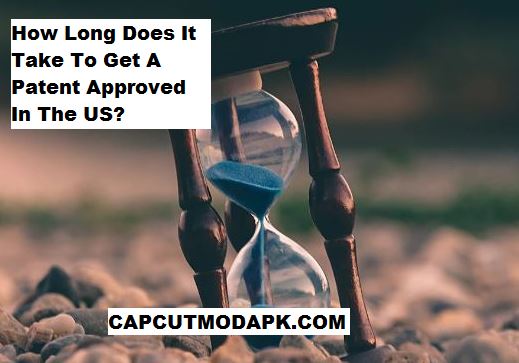If you have an invention that you want to protect, you’re probably asking How Long Does It Take To Get A Patent Approved In The US? The U.S. Patent and Trademark Office (USPTO) handles patent applications, but the approval process is complex and can take several years. The length of time varies based on the type of patent, the complexity of the invention, and the efficiency of the patent examiner. Understanding the timeline is crucial so you can plan accordingly and avoid delays.
Patents are legal protections that give inventors exclusive rights to their inventions, ensuring no one else can produce, use, or sell their creation without permission. However, obtaining a patent is a lengthy process that involves several stages, including filing, examination, and approval. So, How Long Does It Take To Get A Patent Approved In The US? is a question that every inventor should have a clear answer to, especially when developing a product and seeking to commercialize it.
In this article, we’ll dive into the various stages of the patent process, the average wait times, the factors affecting approval, and what you need to do to ensure that your application stands the best chance of success. By the end, you’ll have a better understanding of how long it will take to get a patent approved in the U.S. and what you can expect at each stage.
What Is the Current Wait Time for Patents?
The question of How Long Does It Take To Get A Patent Approved In The US? is one that many inventors face when starting the patenting process. The average time it takes to get a patent granted can range from 1 to 3 years, but it depends on several factors, including the type of patent, the complexity of your application, and the backlog at the USPTO.
For utility patents, which are the most common type of patent for inventions, the current wait time is around 24 to 36 months. Design patents typically have a shorter processing time, with an average approval time of 12 to 18 months. However, there are cases where it may take longer, especially if your application is more complicated or if the USPTO’s examiners face a backlog of applications. Some applications can be delayed due to issues such as insufficient documentation or needing to address examiner rejections.
It’s important to understand that the patent application process can be affected by several variables. For instance, if you’re filing a complex patent with numerous claims, it may take more time for the examiner to review and assess the invention. The time it takes to get a patent approved also depends on how quickly you respond to office actions or requests for additional information from the USPTO.
What Is the Timeline for Patent Approval?
So, How Long Does It Take To Get A Patent Approved In The US? The timeline typically follows a multi-step process. Let’s break down what to expect during the patent approval process, starting with the initial filing.
1. Filing the Application – Once you’ve prepared and submitted your application to the USPTO, it enters the queue for examination. This stage usually takes around 3 to 6 months, depending on the backlog of applications.
2. Patent Examination – After your application is filed, a patent examiner will be assigned to your case. This is where the bulk of the time is spent. The examiner will review the application to ensure that the invention is novel, non-obvious, and useful. This process usually takes 12 to 24 months but can be longer if the examiner needs more information or if your claims are complicated.
3. Office Actions and Amendments – If the examiner finds any issues with your application, they will issue an office action. You will have to respond to this, addressing any concerns or making adjustments to your claims. The back-and-forth between you and the USPTO can extend the timeline by several months, depending on how quickly you can resolve the issues.
4. Approval or Rejection – Once the examiner is satisfied with the application, they will approve it and issue a patent grant. If the examiner finds unresolved issues, they may reject the application, and you will need to appeal or revise your submission.
The total time to get approval can vary significantly depending on these steps, and How Long Does It Take To Get A Patent Approved In The US? can range from about 18 months to 3 years, or even longer in some cases.
How Hard Is It to Get A U.S. Patent?

Another common question when considering How Long Does It Take To Get A Patent Approved In The US? is how difficult it is to actually get a patent granted. The process is certainly not easy, and getting a patent requires a substantial amount of effort, time, and sometimes money. Many factors determine whether or not your application will be successful, including the novelty of your invention, the quality of your submission, and the strength of your claims.
The USPTO is highly selective in granting patents, as they are meant to protect only novel and non-obvious inventions. This means your idea must be new and different from what is already patented or publicly known. If the USPTO determines that your invention is too similar to prior art, they may reject your application.
Additionally, the patent application process requires detailed documentation and a clear description of your invention. The more complex the invention, the more thorough your submission needs to be. You’ll need to provide precise diagrams, detailed explanations, and a clear set of claims that outline the scope of your invention.
The USPTO may also challenge your claims, asking for amendments or clarifications, which can prolong the approval process. While getting a patent is challenging, a well-prepared application can increase the chances of approval.
What Are the 5 Requirements for a Patent?
Before you can answer How Long Does It Take To Get A Patent Approved In The US? it’s important to understand what qualifies for patent protection. There are five main requirements for a patent:
1. Novelty – Your invention must be new and not have been disclosed to the public before. If someone has already patented a similar idea, your invention will not meet this requirement.
2. Non-Obviousness – Even if your invention is new, it must also be non-obvious to someone skilled in the relevant field. This means that the invention must not be an easy or logical extension of existing knowledge.
3. Utility – The invention must be useful and functional. If the invention doesn’t serve any practical purpose, it will not meet the utility requirement.
4. Enablement – You must provide enough detail in your application to allow someone skilled in the relevant field to make and use the invention based on your description. This includes providing clear drawings and detailed explanations of how the invention works.
5. Patentable Subject Matter – Your invention must fall under one of the categories of patentable subject matter, including processes, machines, manufactures, or compositions of matter.
Meeting these five requirements is essential to obtaining a patent. If your invention does not meet any of these criteria, your application will likely be rejected, delaying the patent approval process.
What Disqualifies a U.S. Patent?
Not all inventions are eligible for patent protection. To answer How Long Does It Take To Get A Patent Approved In The US? effectively, you should also know what might disqualify your invention from receiving a patent. Several factors can disqualify an invention, including:
Prior Art – If the invention has already been publicly disclosed or patented, it cannot be patented again. Patent examiners will search existing patents and publications to ensure your invention is new.
Obviousness – If the invention is too similar to existing inventions or could easily be deduced from prior art, it may be deemed obvious and thus not patentable.
Lack of Utility – If the invention is not useful, it will not qualify for a patent. Patent law requires that inventions have a practical and specific utility.
Ineligible Subject Matter – Some things cannot be patented, such as abstract ideas, laws of nature, or natural phenomena. For example, a scientific principle or mathematical algorithm is not patentable.
Non-Enablement – If your application does not provide enough detail or if the invention cannot be reproduced based on the information provided, it may be rejected.
Knowing these disqualifiers will help you avoid unnecessary delays in the patent process. Be sure that your invention meets all the requirements before filing.
How Much Does a Patent Cost?
The cost of obtaining a patent is another important factor when considering How Long Does It Take To Get A Patent Approved In The US? The costs associated with obtaining a patent can vary based on the type of patent and whether you hire a patent attorney.
Filing Fees – The filing fee for a utility patent with the USPTO can range from $75 to $300, depending on the size of the applicant (individual, small business, or large entity). For design patents, the fees are typically around $50 to $200.
Attorney Fees – Patent attorneys charge for their time and expertise, with fees ranging from $5,000 to $15,000 for preparing and filing a patent application. More complex applications may cost even more.
Maintenance Fees – Once granted, a patent requires maintenance fees to keep it in force. These fees are typically paid every 3.5, 7.5, and 11.5 years and can range from $400 to $7,400, depending on the length of time the patent has been in force.
The total cost of obtaining a patent can range from $5,000 to $20,000, depending on the complexity of your application and whether you hire professional help.
Conclusion
To answer the question How Long Does It Take To Get A Patent Approved In The US? the process typically takes 1 to 3 years, depending on various factors such as the type of patent, complexity of your invention, and backlog at the USPTO. The process includes filing, examination, responding to office actions, and approval or rejection.
While the timeline can vary, understanding the steps involved and preparing a high-quality application can help speed up the process. Additionally, knowing the requirements for a patent, the factors that can disqualify your invention, and the costs involved will help you navigate the patent system with confidence.


